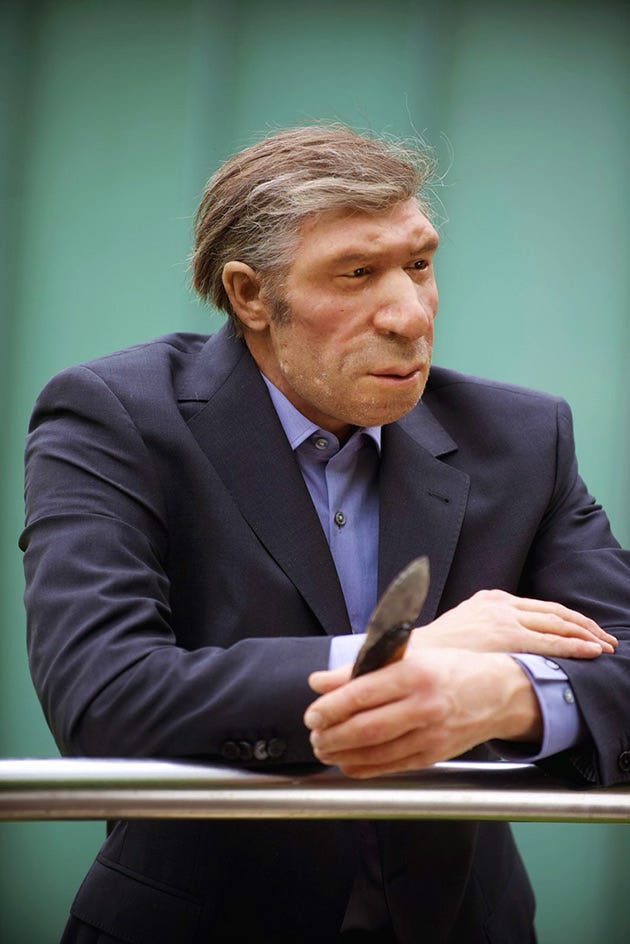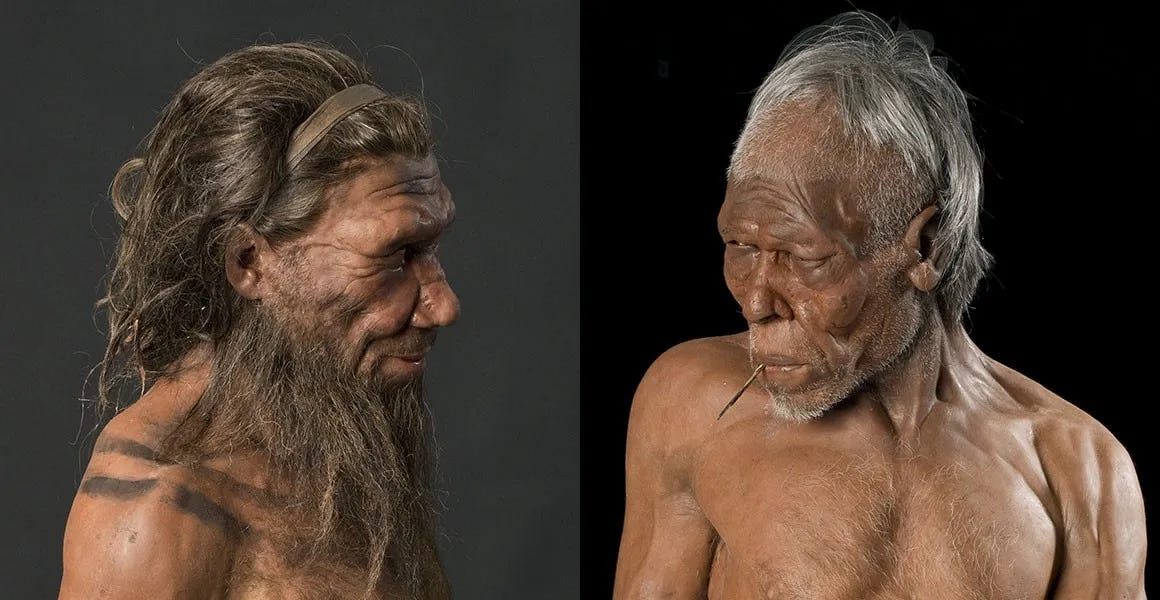Neanderthals Were Not Always Meat Eaters, According to Their Teeth
Their diet was more diverse than we imagine

When we think of Neanderthals, we imagine strong human-like creatures who hunted gigantic beasts such as the woolly mammoth. They were hardy and intelligent enough to hunt animals much larger than them. Recent research reveals that the diet of the Neanderthals was diverse. This is contrary to the popular perception of them being only meat-eaters.
Their diet depended on the region in which they lived.
Neanderthals enjoyed mammoth steaks (literally!). Earlier this year, we saw how they outwitted giant prehistoric elephants 125,000 years ago. Last month, we discovered Neanderthals hunted cave lions 48,000 years ago, and revered them. But that wasn’t the case for those living next to the ocean.
The clues for what Neanderthals ate lie in their teeth. Their dental remains have been preserved for thousands of years as time capsules, providing valuable information.
Their eating habits were similar to ours, with local and seasonal variations. It wasn’t a romanticized carnivore diet. Neanderthals, like humans, foraged, scavenged, and ate what they could find.
Let us look at how dental analysis is changing our ideas about the diet of our extinct cousins, the Neanderthals.
What did Neanderthals eat?

We used to think of Neanderthals as apex predators that hunted woolly mammoths and rhinoceroses. Besides the enormous beasts, scientists later discovered that Neanderthals hunted smaller prey such as reindeer, wild horses, bison, cave hyenas, bears, and lions.
But more recent analyses of their teeth and remains from ancient feces, known as coprolites, suggest the diet of Neanderthals comprised both meat and plants.
Plants in Arctic regions and Northern Europe were more challenging to grow 300,000 years ago. This meant Neanderthals depended on meat as their primary food source. But in El Sat, Spain, coprolites found in an archaeological site suggest they ate mushrooms, pine nuts, moss, and no meat. Scientists also found some fecal samples in a nearby region were meat-rich. This contradicts the widely held belief that Neanderthals were solely meat-eaters. Instead, they ate what they could get and relied on local food availability.
Dental examinations also give fascinating details about the Neanderthals’ daily lives. During the winter, they were forced to drink polluted water and rotten meat because they lacked resources. Neanderthals, like us, ate seasonal foods.
Consumption of seafood and fish is one of the reasons for the development of human brains and why Homo Sapiens survived while other hominids (human-like) species, such as the Neanderthals, went extinct. However, fossil remains discovered along the coast of Portugal reveal Neanderthals consumed shellfish, marine mammals such as dolphins, and pine nuts, besides small terrestrial animals such as wild goats and deer.
The earliest evidence of Homo Sapiens consuming fish and seafood comes from 160,000-year-old archaeological remains in Pinnacle Point, South Africa. Scientists proposed that consuming fish and seafood and the essential omega-3 fatty acids in them resulted in the evolution of our brains. This may have helped humans out-compete our distant cousins, the Neanderthals. With their advanced intellect, Homo Sapiens created cave drawings, sophisticated hunting equipment, and jewelry out of seashells and beads.
However, the findings in coastal Portugal and other archaeological sites challenge this theory of superior human intelligence as the prime reason for survival.
How do the food habits of Neanderthals compare with humans?

Neanderthals were equally skilled at utilizing tools as humans and lived in organized communities. According to Miki Ben-Dor of Tel-Aviv University, we can’t distinguish between human and Neanderthal tools.
“If you go to a site from 150,000 years ago, you won’t be able to tell whether Neanderthals or Homo sapiens lived there, because they had all the same tools.”- Miki Ben-Dor, Archaeologist, Tel Aviv University.
Remains of Neanderthals in caves of Gibraltar considered the last species, suggest that they ate rabbits and scavenged on monk seals and tortoises. They used the caves for cooking and butchering; we can see tool marks on the bones.
Neanderthals were practical creatures whose primary goal was survival, much like humans.
During the time of the Neanderthals, sea levels in Gibraltar were much lower. Hence, archaeologists believe the rising sea levels have swept away much evidence. But there are sufficient clues for us to conclude that Neanderthal brains also developed like that of ancient humans. This debunks the popular notion that our extinct cousins were unintelligent, unlike our human ancestors.
You may wonder why Neanderthals went extinct since they ate like humans, could make tools, butcher meat, and lived in complex hunter-gatherer groups.
It wasn’t the diet.
The physical constitution of the two species may explain the extinction of Neanderthals and the survival of Homo Sapiens. To accommodate bigger lungs and kidneys, the Neanderthal had a wide bell-shaped rib cage. Their pelvises were wider. They needed more energy for day-to-day activity because they lived in a colder climate than our ancestors, hence the giant torso. The enormous upper body and wide pelvis hampered their ability to hunt and move fast as large animals such as the mammoth became extinct.
Humans, in contrast, have barrel-shaped, small torsos and narrower pelvises, allowing them to run faster. The fast movement aided in the speedy hunting and collection of precious food.
But, besides competition for food, there are other factors for Neanderthal extinction. These include interbreeding with humans, violence, cannibalism, and the role of pathogens. While the causes of Neanderthal extinction deserve their own story, it is safe to conclude that their diet didn’t result in their demise, as previously thought.
Modern research is helping us debunk many misconceptions about Neanderthals. They were more skilled than we credit them for. This write-up focused on their diet. If you’d like me to cover more stories about Neanderthals, let me know in the comments or reply to this email.
Do you enjoy tales from lost civilizations and cultures from the ancient world and the Middle Ages?
Share this story with your friends and family and subscribe to this newsletter.
If you wish to support the newsletter, consider buying me a coffee!
References
Neanderthals feasted on seafood and nuts according to fossil remains, New Scientist.
Neanderthals diet: 80% meat, 20% vegetables, Science Daily.
New evidence debunks ‘stupid’ Neanderthal myth, Eureka Alert.
Neanderthal teeth reveal intimate details of daily life, National Geographic.


The more we continue to learn about Neanderthals, the more we start to understand that they were us, and we were them. I'm not even convinced cro-magnons were smarter per se, but they certainly outbred Neanderthals (and subsumed them into the same species!).
Love this!
How did the ancient Romans feed their armies? Why did the tradition of feasting begin? When was the potato chip invented? Explore when foods were first cultivated, from prehistory to present day:
https://thesecretingredient.substack.com/p/when-did-your-favorite-foods-originate